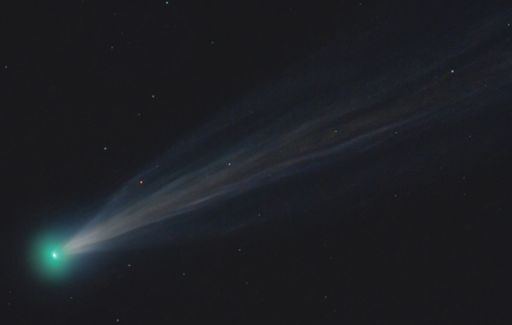RARE DOUBLE-COMET FLYBY OF MERCURY: NASA's MESSENGER spacecraft is about to get a close-up view of Comet ISON's outburst. On Nov. 18-19 Comet ISON and Comet Encke both will fly by Mercury, the planet MESSENGER is orbiting. You can learn more about this rare double-comet flyby and what MESSENGER might see in a video from Science@NASA.
COMET ISON OUTBURST CONTINUES: The abrupt brightening of Comet ISON on Nov. 14th has pushed the comet into the range of naked eye visibility. Dark-sky observers around the world report seeing it with their unaided eyes on the morning of Nov. 15th. To the human eye, ISON is just a faint smudge of magnitude +5.5. Backyard telescopes are revealing much more. The effects of the outburst have propagated into the comet's suddenly riotous tail, as shown in this image taken just hours ago by Jerry Lodriguss of Atsion, New Jersey:
"After its recent outburst, Comet ISON was looking very interesting this morning with multiple streamers in the tail," says Lodriguss.
These changes (the increase in brightness and riotous emergence of gaseous streamers) could be caused by fresh veins of ice opening up in the comet's nucleus. Rapid vaporization of ice by solar heat is a sure-fire way to boost a comet's visibility. But, as NASA's Comet ISON Observing Campaign states, "we have no idea." The comet's nucleus is hidden from view by a hazy green atmosphere, so events in the interior remain a mystery.
"I have a strong suspicion that this is Comet LINEAR (C/1999 S4) all over again," says Mark Kidger of the ESA's European Space Astronomy Centre in Madrid. In the year 2000, Kidger other astronomers monitored Comet LINEAR as it disintegrated en route to the sun. "The sudden appearance of ISON's gas tail, the increasing fuzziness of its coma, and now this sudden outburst all remind me of C/1999 S4 just before it broke apart."
To reiterate: No one knows what is happening to Comet ISON. This could be the comet's death throes--or just the first of many brightening events the comet experiences as it plunges toward the sun for a close encounter on Thanksgiving Day (Nov. 28th).
Monitoring is encouraged. Comet ISON rises in the east just before the sun. Amateur astronomers, if you have a GOTO telescope, enter these coordinates. Dates of special interest include Nov. 17th and 18th when the comet will pass the bright star Spica, making ISON extra-easy to find. Sky maps: Nov. 15, 16, 17, 18, 19.

Solar wind
speed: 355.9 km/sec
density: 8.3 protons/cm3
explanation | more data
Updated: Today at 1847 UT
X-ray Solar Flares
6-hr max: C1 1739 UT Nov15
24-hr: M1 0229 UT Nov15
explanation | more data
Updated: Today at: 1800 UT
![]()
Daily Sun: 15 Nov 13
Sunspot AR1897 has a 'beta-gamma' magnetic field that harbors energy for M-class solar flares. Sunspot complex AR1893-1900 is growing rapidly. Credit: SDO/HMI
![]()
Sunspot number: 234
What is the sunspot number?
Updated 15 Nov 2013
Spotless Days
Current Stretch: 0 days
2013 total: 0 days (0%)
2012 total: 0 days (0%)
2011 total: 2 days (<1%)
2010 total: 51 days (14%)
2009 total: 260 days (71%)
Since 2004: 821 days
Typical Solar Min: 486 days
Update 15 Nov 2013
The Radio Sun
10.7 cm flux: 176 sfu
explanation | more data
Updated 15 Nov 2013
![]()
Current Auroral Oval:
Switch to: Europe, USA, New Zealand, Antarctica
Credit: NOAA/POES
![]()
Planetary K-index
Now: Kp= 2 quiet
24-hr max: Kp= 2 quiet
explanation | more data
Interplanetary Mag. Field
Btotal: 5.7 nT
Bz: 3.7 nT south
explanation | more data
Updated: Today at 1846 UT
![]()
Coronal Holes: 15 Nov 13
Solar wind flowing from the indicated coronal hole could reach Earth on Nov. 17-18. Credit: SDO/AIA.





